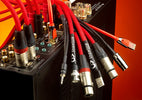
Everything You Need To Know About HI-FI Cables
, by Haim Deutsch, 4 min reading time

, by Haim Deutsch, 4 min reading time

Everything You Need to Know About HiFi Cables The question "Does Hi-Fi even exist anymore?" is one we are asked daily. Of course, it does.
Worldwide Cable Technology looked up the term in the Urban Dictionary to make sure we were defining it correctly.
The term "high fidelity" or "hi-fi," which also refers to high-quality but monoaural music players, first appeared in the middle of the 20th century.
When stereo became the norm, the term "hi-fi" lost its popularity.
Today, audiophiles and home audio enthusiasts may use the term "hi-fi" to distinguish between high-end sound systems and schlock.
Hi-fi cables were used in the 1950s to link record players, amplifiers, and speakers.
A person meant to sit around and listen to vinyl records when they claimed they wanted to hear the hifi.
Signals are now sent to and from digital audio tape (DAT) recorders and HD radio tuners using hifi cables and contemporary hi-fi equipment.
Several pieces of contemporary hi-fi gear communicate using serial bus ports and fibre optic cables.
WMA and lossless FLAC files The best way to hear lossless files is with premium hifi cables from Worldwide Cable Technology.
You may discover any type of audio cable you need in our online catalogue, regardless of what it is.
We specialise in hifi cables, and we're happy to provide a wonderful assortment of cables that make use of our numerous patents, such as DNA HELIX.
Our sound professionals will assist you in selecting the hifi cables that are ideal for your needs after learning more about the type of audio equipment or home entertainment system you have.
The Stream 8 speaker wire from DNA HELIX is a decent, inexpensive speaker cable that packs a powerful punch without being overly expensive.
Stream 8 hifi cables are the market leader in reasonably priced stereo wires and are punchier than many cables twice their size.
There are several audio cables for analogue and digital systems.
Each cable in a Hi-Fi system performs a specific function and serves a certain purpose.
In order to achieve the best sound restitution, it is vital to properly position each cable.
If you want to add a turntable to your Hi-Fi system, a phono cable is a necessity.
The turntable is in fact connected to the phono preamplifier by a phono cable.
It is frequently confused with an interconnect cable.
An interconnect cable, which is frequently confused for a phono cable and vice versa, is completely distinct and serves a very different purpose in a hi-fi system.
An interconnect cable is required to connect a CD player, for instance, to your amplifier.
Speaker cables, which are available in pairs or by the metre, link the amplifier to the Hi-Fi speakers.
The audio signal is sent across speaker cables to the speakers, which produce the sound.
Hi-Fi equipment is connected to power outlets using power cables.
They enhance the Hi-Fi system's ability to reproduce sound.
Of course, the purpose of a power line is to reduce the high frequencies radiated and allow the cleanest current (50 Hz or 60 Hz) to pass through.
By doing this, harmonics, distortion, and other sound-altering factors are eliminated.
A digital cable can be used to link digital sources as well.
There are different types of digital cables, including:
Conclusion
We truly hope that this tutorial was helpful in illuminating the distinctions between each audio cable used in a hi-fi system and, more specifically, the functions performed by each of these hi-fi cables.
Please feel free to reach out to our professionals at 0208 066 1611 or sales@joeaudio.co.uk for further details.